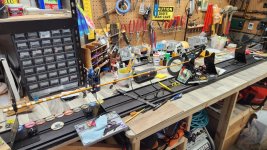I'm scratching my head a little bit over your SFG question. All the Single Foot Fly Guides I've sourced are sized using the same ring sizing as snake guides - typically 4 thru 1/0 or 2/0 depending on your build. Check Angler's Workshop and Proof Fly Fishing for a good selection of SFGs.
In my experience, there are rules of thumb for guide sizing that are often good starting points for many before adjusting based on personal preference. For fly rods, the universally accepted best place to start is using Tom Morgan's (of Winston fame) Guide Spacing and Sizing Chart. It's posted on the Snake Brand Guide website:
Morgan's M.O. was always to transition guides to small sizes quickly to limit line wobble and increase shooting accuracy. Most agree. Some very good rod builder's will drop a size over successive guides working up from the stripping guide until they get to their desired end size and finish with them . . . example: 9mm stripper followed by 1x3, 1x2, 1x1, 1x1/0, and the 2/0's the rest of the way. Me: I usually start by landing guides on a blank using Morgan's spacing BUT, I generally up-size guides one size - I'll transition down to 1/0, not 2/0, and then static test and move guides up or down depending on the rod's load profile. I very seldomly build out to 2/0 guides.
I'll PM you a few links of info I have bookmarked that'll provide perspective on the different approaches builders take.
For keeping guides in place while wrapping, I've experimented with dental bands, dubbing wax, CRB's micro guide bands (you can find them at Mudhole), and even a quick swipe across a stick to tip top cement but always fall back to thin tape to hold the guides in-place. Yes, as you get into the thinner sections of the build, the wraps get a little more challenging. Do your best to close the distance between your supports as much as you can to reduce the flex. That helps. With regard to super glue, I'v ealways been taught it's rod-building blasphemy as well. Rule of thumb is anytihng attached with super glue becomes permanent and you could risk blank damage by using it. For me, without any scientific proof whatsoever, I was always worried about it indriducing a point of rigidity that at some point would become a potential stress initiation point.
Fighting butts is another area of personal preference but for a 8+ WT, I can see the advantage. Thinking about it, it seems there aren't a lot of factory rods coming without them.
BTW: love the rainshadow blanks. Built a bunch of "tadpoles" using them, and have a bunch of blanks stashed in the basement rafters for future builds. They're cheap enough, I usually buy them in qtys of two: one to section and one to use as exact taper match spigot stock.

 mudhole.com
mudhole.com

 mudhole.com
mudhole.com





